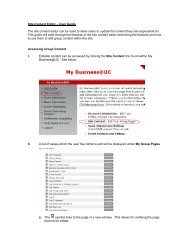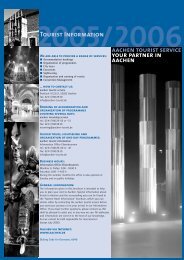The Economic Impact of a Minor League Baseball Team in Florence Kentucky
The Economic Impact of a Minor League Baseball Team in Florence ...
The Economic Impact of a Minor League Baseball Team in Florence ...
Create successful ePaper yourself
Turn your PDF publications into a flip-book with our unique Google optimized e-Paper software.
<strong>The</strong> <strong>Economic</strong> <strong>Impact</strong> <strong>of</strong> a<strong>M<strong>in</strong>or</strong> <strong>League</strong> <strong>Baseball</strong> <strong>Team</strong> <strong>in</strong><strong>Florence</strong>, <strong>Kentucky</strong>Prepared for theCity <strong>of</strong> <strong>Florence</strong>Prepared by theCenter for <strong>Economic</strong> EducationUniversity <strong>of</strong> C<strong>in</strong>c<strong>in</strong>natiMay, 2001
<strong>Economic</strong> <strong>Impact</strong> <strong>of</strong> a <strong>M<strong>in</strong>or</strong> <strong>League</strong> <strong>Baseball</strong> <strong>Team</strong> <strong>in</strong> <strong>Florence</strong>, <strong>Kentucky</strong><strong>Economic</strong>s Research Group – Center for <strong>Economic</strong> Education – University <strong>of</strong> C<strong>in</strong>c<strong>in</strong>natiIntroduction<strong>The</strong> City <strong>of</strong> <strong>Florence</strong>, <strong>Kentucky</strong> is consider<strong>in</strong>g an opportunity to <strong>in</strong>vest <strong>in</strong> abaseball stadium that will be home to a team <strong>in</strong> the Frontier <strong>League</strong>, an<strong>in</strong>dependent m<strong>in</strong>or league with teams throughout the Mid-west. <strong>The</strong> purpose <strong>of</strong>this study is to estimate the potential impact <strong>of</strong> a m<strong>in</strong>or league baseball team onthe economy <strong>of</strong> <strong>Florence</strong>, <strong>Kentucky</strong>. <strong>Economic</strong> impacts result from new moneyspent <strong>in</strong> <strong>Florence</strong> by the baseball team and by visit<strong>in</strong>g teams and fans. <strong>Impact</strong>salso result from money spent by local fans that spend their money <strong>in</strong> <strong>Florence</strong>rather than elsewhere <strong>in</strong> the region. Money spent <strong>in</strong> <strong>Florence</strong> affects total bus<strong>in</strong>essoutput and employment <strong>in</strong> the city and surround<strong>in</strong>g area.Methodology<strong>The</strong> impact <strong>of</strong> a baseball stadium on the local economy depends on the amount <strong>of</strong>“new money” that it br<strong>in</strong>gs <strong>in</strong>to the region. That is, it depends on the amount <strong>of</strong>spend<strong>in</strong>g <strong>in</strong> the region that would not have occurred if not for the stadium. In thiscase, money brought <strong>in</strong>to the region <strong>in</strong>cludes that spent locally by the m<strong>in</strong>orleague team <strong>in</strong> its day-to-day operation, <strong>in</strong>clud<strong>in</strong>g salaries <strong>of</strong> personnel. Thisspend<strong>in</strong>g represents an <strong>in</strong>crease <strong>in</strong> the demand for the goods and services thatlocal bus<strong>in</strong>esses provide. It is considered new money because it is assumed thatthis spend<strong>in</strong>g would not occur locally <strong>in</strong> any other form if the team did not exist <strong>in</strong><strong>Florence</strong>.New money is also <strong>in</strong>jected <strong>in</strong>to the local economy by baseball fans that comefrom outside <strong>of</strong> <strong>Florence</strong> <strong>in</strong> order to see games. In this case, visit<strong>in</strong>g fans <strong>in</strong>cludelocal team fans that do not live <strong>in</strong> <strong>Florence</strong> and visit<strong>in</strong>g team fans that travel to<strong>Florence</strong> to watch their teams play. <strong>The</strong>se visitors spend money at hotels,restaurants, clubs, retail stores, and other bus<strong>in</strong>esses. Money spent by <strong>Florence</strong>residents is not <strong>in</strong>cluded because it is assumed that this money would have beenspent elsewhere <strong>in</strong> <strong>Florence</strong> on some alternate activity if the baseball team did notexist. <strong>The</strong> economic impact estimation does not count the money that baseballfans spend on tickets for games. It is assumed that this revenue pays for teamoperations and has therefore been counted already <strong>in</strong> the impact estimation.Total spend<strong>in</strong>g on team operations plus money spent by visitors to the cityrepresents the direct economic impact <strong>of</strong> the baseball team on the local economy– it is spend<strong>in</strong>g that can be directly attributed to host<strong>in</strong>g m<strong>in</strong>or league baseballgames. Local bus<strong>in</strong>esses that have received this new money will re-spend some <strong>of</strong>these receipts locally <strong>in</strong> order to meet expenses and pay employees. Thus, thereare successive rounds <strong>of</strong> re-spend<strong>in</strong>g <strong>in</strong> the region by those bus<strong>in</strong>esses that havesupplied goods and services to the team and fans. <strong>The</strong>se successive rounds <strong>of</strong> respend<strong>in</strong>gare called the <strong>in</strong>direct impact. Only money that is spent with<strong>in</strong> the localarea is <strong>in</strong>cluded <strong>in</strong> the <strong>in</strong>direct impact. Money received by bus<strong>in</strong>esses outside thearea is not considered <strong>in</strong> this part <strong>of</strong> the analysis.1
<strong>Economic</strong> <strong>Impact</strong> <strong>of</strong> a <strong>M<strong>in</strong>or</strong> <strong>League</strong> <strong>Baseball</strong> <strong>Team</strong> <strong>in</strong> <strong>Florence</strong>, <strong>Kentucky</strong><strong>Economic</strong>s Research Group – Center for <strong>Economic</strong> Education – University <strong>of</strong> C<strong>in</strong>c<strong>in</strong>natiMoney earned by employees <strong>of</strong> those bus<strong>in</strong>esses generat<strong>in</strong>g output <strong>in</strong> both thedirect and <strong>in</strong>direct phases <strong>of</strong> the impact is also counted because much <strong>of</strong> this<strong>in</strong>come is spent locally. Purchases by households that have experienced <strong>in</strong>creasedearn<strong>in</strong>gs due to the <strong>in</strong>jection <strong>of</strong> new money <strong>in</strong>to the region are known as <strong>in</strong>ducedimpacts. In the context <strong>of</strong> the economic impact estimation methodology, direct,<strong>in</strong>direct and <strong>in</strong>duced impacts are comb<strong>in</strong>ed <strong>in</strong>to a s<strong>in</strong>gle figure represent<strong>in</strong>g thetotal multiplier effects <strong>of</strong> bus<strong>in</strong>ess-to-bus<strong>in</strong>ess and household-to-bus<strong>in</strong>essspend<strong>in</strong>g with<strong>in</strong> the local area.This economic impact estimation uses the RIMS II 1 system developed by the U.S.Department <strong>of</strong> Commerce Bureau <strong>of</strong> <strong>Economic</strong> Analysis (BEA). <strong>The</strong> BEA hasestimated a set <strong>of</strong> multipliers based on purchaser-supplier (or <strong>in</strong>put-output)relationships among bus<strong>in</strong>esses <strong>of</strong> different <strong>in</strong>dustry classes with<strong>in</strong> Boone County.<strong>The</strong>se multipliers are used to estimate the total economic impact <strong>of</strong> a change <strong>in</strong>local spend<strong>in</strong>g associated with a given bus<strong>in</strong>ess. <strong>The</strong>y are also used to estimatethe number <strong>of</strong> new jobs that are created when bus<strong>in</strong>ess sales <strong>in</strong>crease. Thisemployment impact is stated <strong>in</strong> full-time job year equivalents.New workers must be paid wages, or exist<strong>in</strong>g workers must be paid higher wages<strong>in</strong> order to produce the <strong>in</strong>creased output. <strong>The</strong> impact on household earn<strong>in</strong>gsrepresents the change <strong>in</strong> the amount <strong>of</strong> wages and salaries that must be paid toworkers <strong>in</strong> the area <strong>in</strong> order to generate the additional output.1 RIMS is an acronym for Regional Input-output Model<strong>in</strong>g System.2







